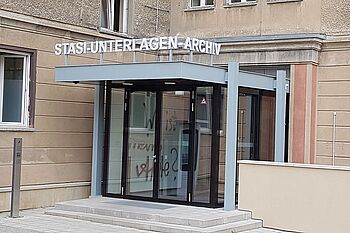The GDR State Security Service left behind 111 kilometers of files. Today they are stored in the Stasi Records Archive (photo). Many documents from the Nazi era have also survived, most of which are held in the German Federal Archives. Some documents are also stored decentrally – in the archives of the federal states and cities, memorial sites, companies and associations. These sources are invaluable to an historical examination of the past.
Credit: Hubertus Knabe
More than 400 kilometers of files

Credit: Holger Weinandt / CC BY-SA
The clunky Federal Archives building in Koblenz is not very inviting. But for historians, the archive is a gold mine. Its nearly 900 employees manage over 400 kilometers of files, 13 million images and 155,000 films. As a rule, research in the archive is free of charge. The key to the source-based examination of the past is a special archive law.
Germany has had a central state archive for more than 100 years. This is where the documents of the German Federation, the German Reich, the GDR and the Federal Republic are preserved. The holdings of the NSDAP and the GDR parties are stored there too. Access is regulated by the Federal Archives Act of 1988, which stipulates that public agencies of the central state must provide no longer needed documents to the Federal Archives – no more than 30 years after their creation. The archives then decide whether the records have historical value and should preserved permanently.
The protection period for the use of documents is usually 30 years from the date of creation. If individuals are affected, the period ends at the earliest ten years after their death or 100 years after their birth. These protection periods can be reduced in individual cases. The 30-year retention period after German reunification for documents from the GDR was lifted in order to facilitate a reappraisal of the SED dictatorship. Over the past decades, thousands of reference books, essays and films on the National Socialist and Communist regimes have been created using archival material from the Federal Archives.
There are, however, considerable gaps in the inventory. The Gestapo, for example, destroyed a large amount of its own files. The most comprehensive collection of preserved files comes from the State Police Office in Düsseldorf and is stored in the State Archive of North Rhine-Westphalia. Many documents were destroyed during World War II. Moreover, large holdings were confiscated by the Allied Powers and only partially returned. As part of a joint project, some of the files stored in Russia have now been made available online. The SED party archive also remains incomplete. When it arrived at the Federal Archives in late 1992, the complete membership file and all nomenclature cadre files had been destroyed.
The Military Archives, which are located in Freiburg, are also a part of the Federal Archives. Foreign policy files are kept separately in the Political Archive of the Foreign Office. After reunification, this office also took control of the documents from the GDR Foreign Ministry. Only a small section of the Federal Archives’ holdings has been made accessible online – a total of around 57,000 files, including the minutes of the SED Politburo meetings. A large part of the holdings can be searched via the Internet, but in most cases, to view the files, researchers have to visit in person one of the nine locations scattered across Germany. Another point of criticism is that private media are charged a high fee for the right to publish historical photos and documents.
Click here for the text of the Federal Archives law.
Links
Website of the German Federal Archives
Website of the Political Archives of the Foreign Office
Website of the State Archive of North Rhine-Westphalia
Overview portal to the archives in Germany
German documents in Russian archives (German and Russian)
Website of Archive Portal Europe
Online Archive on Nazi Forced Labor (German)
After the Dictatorship. Instruments of Transitional Justice in Former Authoritarian Systems – An International Comparison
A project at the Department of Modern History at the University of Würzburg
Twitter: @afterdictatorship
Instagram: After the dictatorship
With financial support from the German Federal Ministry for Economic Cooperation and Development
The Stasi Archive

Credit: Hubertus Knabe
The entrance to the Stasi Records Archive in the former Stasi headquarters in Berlin feels more like a side door. But behind it, 44 kilometers of once top-secret files from the GDR secret police are stored. An additional 68 kilometers are held in the 13 former GDR district capitals. It is a small miracle that so many documents of the State Security Service have survived.
If it had been up to Stasi boss Erich Mielke and his successor Wolfgang Schwanitz, the most important documents of the GDR secret police would have been destroyed in the fall of 1989. But courageous GDR citizens managed to gain access to the Stasi offices by December 4, 1989. Together with public prosecutors and police, they sealed the archive rooms, thus putting a stop to the large-scale destruction of documents. The existence of some 16,000 bags of torn paper still attests to the destructive rage of the Stasi.
In September 1990, civil rights activists went on a hunger strike to prevent the Stasi files from being transferred to the Federal Archives. Instead a parliament-elected federal commissioner was placed in charge of a new agency that had as many as 3,000 employees at one time. After a long debate, the Stasi Records Act went into effect in 1992. The law regulated the management of sensitive documents covering forty years of surveillance.
The law stipulated that all Stasi documents were to be placed under the authority of the commissioner. This would prevent files from roaming freely as has happened in other former communist countries. Access to files is only granted for clearly defined purposes. Public prosecutor’s offices are able to inspect files for legal investigations connected with the SED regime and victims have the right to view files about themselves. The law allows documents to be used to check whether people – civil service employees in particular – had any involvement with the Stasi. Finally, historians, journalists, and other interested parties are also granted access to the files if they are engaging in an examination of the past. The law was unusual in that it required the consent of Stasi victims for the release of their files, but no consent is necessary for the release of files on Stasi employees and informants. In other countries it is often the other way around, which ends up protecting the very people who were responsible for the persecution measures.
The fact that more than 70 former Stasi employees were employed at the Stasi Records Agency was harshly criticized. Most of them had been transferred to the GDR Ministry of the Interior in 1990 and were reassigned to the Federal Commissioner after reunification. A further nuisance was the long waiting time – sometimes more than two years – for victims to receive their own files. A significant obstacle for historians and journalists is the stipulation, imposed for privacy reasons, that the names of uninvolved persons and victims be redacted. A long legal dispute also erupted in 1999, when former German Chancellor Helmut Kohl refused to allow documents about him to be released to historians.
In 2019, the Bundestag decided to have the Stasi Records Archive transferred to the Federal Archives by 2021. The previous legal regulations will continue to apply, but the number of locations in East Germany will be reduced to five. Several archives in addition to the Stasi Records Archive, the German Federal Archives and the East German State Archives also hold documents from the time of the GDR.
Click here for the Stasi Records Act.
Links
Website of the Federal Commissioner for the Records of the Stasi
Archives of the Foundation on the Reappraisal of the SED Dictatorship (German)
Archives of the Robert-Havemann-Gesellschaft (German)
Audio documents on the June 17, 1953 uprising (German)
The German Compensation Laws

Credit: Piotr Drabik from Poland / CC BY 2.0
Prisoner uniforms in German concentration camps were marked by blue and white stripes. This conspicuous “zebra clothing” was supposed to make an escape more difficult. After the Nazi era, it became a symbol for former camp inmates. At memorial events, such as here at the Auschwitz Memorial on January 27, 2014, survivors often wore a blue and white striped scarf. In Germany, a whole series of laws and regulations were enacted to compensate the victims of political persecution.
The first law providing compensation for injustices committed under National Socialism was passed in 1949, before the Federal Republic had even been founded. The regulations, which initially only applied in the American occupation zone, became federal law in 1953 when the Supplementary Compensation Act was passed.
After long negotiations, the Federal Compensation Act (BEG) was passed in 1956, coming into force retroactively on October 1, 1953. It provided either financial compensation or a pension to victims of Nazi persecution. People who had been “persecuted for reasons of political opposition to National Socialism or for reasons of race, creed or belief under National Socialist tyranny” were eligible to claim compensation. Persecuted homosexuals or so-called antisocial persons were not eligible. Claimants had to prove that they had suffered damage to life, body, freedom, property, assets or professional advancement. A prerequisite for compensation was residency within the 1937 borders of the German Reich.
In the GDR, an order was issued in 1949 to formally recognize those who had been persecuted by the Nazis. In 1965 and 1976, two ordinances followed, providing a so-called honorary pension. “Fighters against fascism” – which generally referred to communists – were granted a special monthly pension, which ultimately reached 1,700 GDR marks per month. Other “victims of fascism,” such as Jews or homosexuals, received 1,400 GDR marks. Children and spouses of deceased persons were also entitled to a pension.
When the GDR joined the Federal Republic in 1990, the regulation – without the two-tier system – was incorporated into German federal law. In 1992, it was replaced by the Compensation Pension Act, which continued the payments. The special pension is currently at 717.50 euros, but continues to be subject to adjustment. A person who violates the basic principles of humanity or the rule of law can lose the pension entitlement. This happened, for example, to Markus Wolf, former GDR chief of foreign intelligence, who was sentenced to two years in prison in 1997 for depriving people of their liberty and other offences. The GDR head of state and party leader Erich Honecker, on the other hand, continued to receive the special pension until his death in 1994.
To compensate Jewish victims outside Germany, in 1952 the Federal Republic signed the Luxembourg Agreement, agreeing to pay Israel and the Jewish Claims Conference the equivalent of 1.79 billion euros. The GDR rejected such payments and also refused to return Jewish property. In 2000, when German companies were threatened by a legal suit in the United States, a Law to Establish a Foundation for Remembrance, Responsibility and the Future was passed, which for the first time provided compensation to former forced laborers. According to this law, imprisoned forced laborers were entitled to a one-time payment of up to 7,669 euros; forced laborers who had been deported could receive up to 2,556 euros.
According to a document from the Federal Ministry of Finance, by the end of 2016 the Federal Republic had paid a total of 74.5 billion euros in compensation for Nazi injustices (not taking into account variances in purchasing power). According to the federal government, around 53,000 people were still receiving a special pension in 2012.
In the Federal Republic of Germany, people persecuted under Communism have received compensation under the Prisoner Assistance Act since 1955. It provides aid to alleviate an emergency situation and a pension for former prisoners who suffered physical damage as a consequence of their imprisonment. In September 1989, the GDR People’s Assembly also passed a rehabilitation law. For reasons of expense, however, when the GDR joined the Federal Republic of Germany, only the criminal rehabilitation section was adopted.
In 1992, the First Law to Eradicate SED Injustice came into force. For victims of the GDR regime living in West Germany, it provided a one-time compensation, equivalent to about 150 euros for every month spent in prison. Victims living in East Germany received an additional 125 euros. Eight years later, the amount was raised to 307 euros, which corresponded with the average prison compensation provided in the Federal Republic. Anyone who was wholly or partially unable to work as a result of imprisonment was entitled to a damage provision. More than 95 percent of the claims were rejected, however, because the claimants were required to prove the causal connection between their imprisonment and their illness. People who had been persecuted outside the GDR or by Soviet authorities were not entitled to any compensation. In 2007, the law was supplemented by a monthly victim’s pension of 300 euros (raised to 330 euros in 2019). To qualify, victims had to have been imprisoned for at least 90 days and have a monthly income only slightly above 1,000 euros.
The Second Law to Eradicate SED Injustice, passed in 1994, regulated the administrative and professional rehabilitation of peopled who had suffered persecution under Communism. It allowed for decisions by the authorities, such as forced resettlement, to be revoked. It also called for the return or replacement of confiscated assets. The persecution periods were also recognized by the pension insurance system. The law made it easier for victims of the SED dictatorship to receive support if they wanted to pursue training or studies. In certain cases, the law also provided aid to the disabled and to surviving dependents. The amount of compensation paid, however, was far below that received by victims of the Nazi regime. Loss of earnings was not compensated, nor was forced labor during imprisonment or lost opportunities for career advancement. The families of refugees who were shot and killed were left empty-handed.
The German Federal Law for Victims of National Socialism is published here. The First Law to Eradicate SED Injustice is here, the Second Law is here (all in German).
Links
Brochure from the German Federal Ministry on Compensation for Nazi Injustice
Chronology of compensation regulations for Nazi victims (German)
Analysis of the implementation of the First Law to Eradicate SED Injustice in Saxony (German)
Brochure on the Second Law to Eradicate SED Injustice (German)
Research report on the social state of SED victims in Thuringia (German)